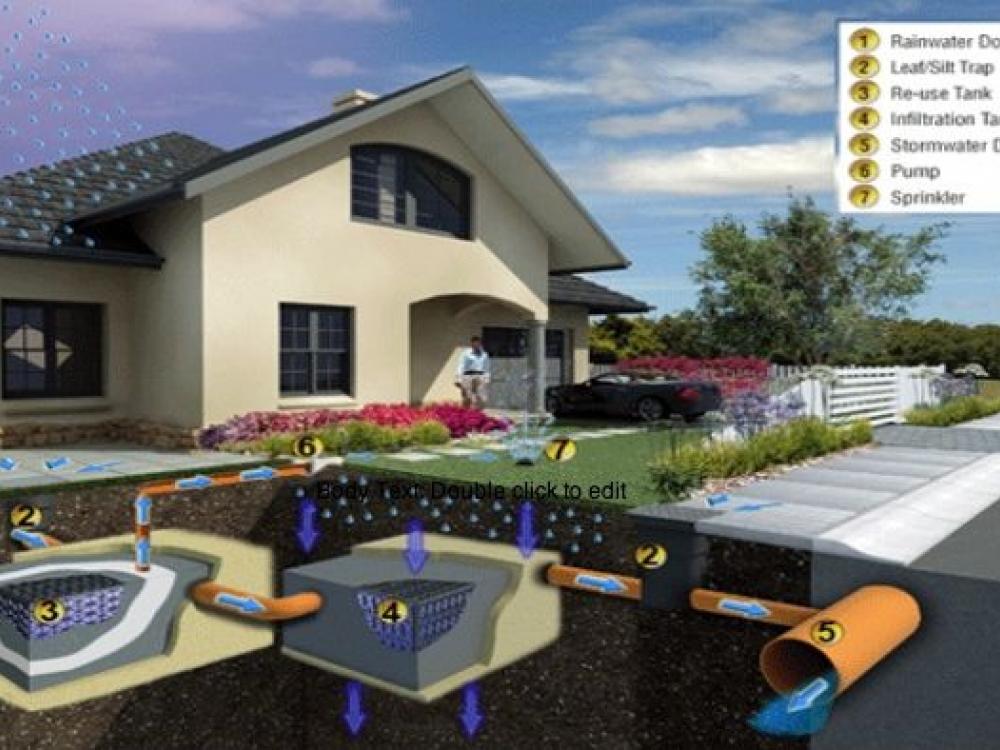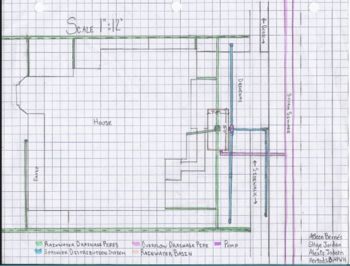
Northwest High School students in Justin came up with products to address local environmental problems, like this French Drain system. Images courtesy of Northwest High School.
Oct. 19, 2015
 John Klingseisen’s students at Northwest High School's STEM Academy in Justin are preparing for careers in science, technology, engineering and math. But as a social studies teacher, he wanted them to ponder technology’s impact on the environment.
John Klingseisen’s students at Northwest High School's STEM Academy in Justin are preparing for careers in science, technology, engineering and math. But as a social studies teacher, he wanted them to ponder technology’s impact on the environment.
So for a recent class project, he teamed up the school’s engineering teacher and asked students to develop a product to address pressing environmental issues in the DFW area.
John Klingseisan wanted his social studies students at Northwest High School's STEM Academy to take a crack at local environmental problems.
Klingseisen said he searched for information about local environmental issues and found GreenSourceDFW.org.
“Classes have been reviewing the website and searching for alternative ways of using our environment in order to protect it,” he wrote us in an email.
He narrowed topics down to three issues: fracking, coal plants and water conservation.
Then the 62 STEM high school sophomores were split into teams and asked to focus on one of the issues. Over the course of three weeks, he challenged them to come up with products that would address concerns surrounding these issues.
Last month, the students presented their digital reports and Klingseisen shared with GreenSourceDFW.org a few of the most outstanding submissions.
The budding inventors came up with rubber tubing to go around fracking well pipes to prevent breaches to ground water; a French drainage system to collect water runoff on lawns; and a solar powered sprinkler that measures the height of a lawn for even distribution. Then there's the whimsically named Texas Sawd “hay juicer,” which extracts water from the crop stocks leftover from harvest.
Klingseisen said the assignment demonstrated to them how their work could improve the quality of life of their own community.
“There’s never a day that they came in and said 'Why are we are learning this?'”
Click on the product titles to link to the full reports.
 Rubber tubing to surround fracking pipe
Rubber tubing to surround fracking pipe
By Hector Almada-Mill, Derek Maynard and Thomas Doughtie
Problem: In the DFW area, the pipes that are used by fracking companies to extract methane gas leak. Even though the pipes are surrounded by concrete it is too brittle and does not have the ability to seal the pipe to prevent the leaks. The methane leaks are contaminating the drinking water around these fracking sites.
Solution: The solution to this issue would be to enclose the pipe in a "self-healing" rubber material, which can be stretched to extreme measures and still return to its original length and state. The pipe would then be surrounded in a bigger pipe that would also be surrounded with a rather thick layer of rubber to prevent a leak from occurring, which would keep the methane out of the drinking water, reducing health problems that come from consuming methane.
 French drain for rain runoff
French drain for rain runoff
By Ali Bernes Alfaro, Alexis Jodoin, Skye Jordan
Problem: In DFW, water usage and storage has been a major issue. According to texaslivingwater.org, 50 percent of the water we use to water our lawns either evaporates or runs off, which causes even more problems for the environment. Our product helps reduce this figure in an attempt to help our water supply.
Solution: We would have large basins under houses to collect rainwater from the gutter, and also from the lawn. Under the lawn, we would have a drainage system that collects excess water that seeps from the soil, though a fine mesh, and then goes to the basin to reuse again for the lawn, eliminating the problem of runoff.
 Hay Juicer
Hay Juicer
By Lawrence Thayer, Logan Stollfus, Wesley Watrous
Problem: From 2010 to 2060, the population of DFW is expected to roughly double, from 6.6 million to 13.1 million. The water use will increase 87 percent, from 1.8 million acre-feet per year in 2010, to 3.3. million acre-feet in 2060.
Solution: The total area of Texas farmland is more than 78 percent of Texas. That is a 130 million plus acres of lands. This amount of land and hay adds up to millions of gallons of water. The Sawd Juicer is a machine that intakes unharnessed stalks of crop and essentially juices and churns the reused stalks into hay bales and water. For every 5 acres if land, it makes 3 bales of hay. Each hay bale is approximately 30 pounds dry, and 80 pounds wet, filled with water. That is 50 pounds of water per hay bale. With over 130 million acres of land that is, over 5 million gallons of water, and the process is repeated constantly through the season, estimating over 10 to 15 million gallons of water supplied for Texas.
 Sprinkler Sensor
Sprinkler Sensor
By Zac Newman, Christian Mangrove, Goeff Hanthorn
Problem: As the population in the DFW area continues to grow over the next few decades, there will be increased demand for water.
Solution: Our main idea to address this problem was to create a sprinkler system that saves hundreds of gallons every use and waters the lawn more effectively. This sprinkler head not only conserves water, but waters your lawn more evenly. Using the energy gathered from the solar panel on the top of the sprinkler, a motor propels the nozzle upwards to measure the height of the grass for even distribution of water. The nozzle will let out a mist instead of a water stream.
Sign up for the weekly Green Source DFW Newsletter to stay up to date on everything green in North Texas, the latest news and events. Follow us on Facebook, Twitter and Pinterest.









